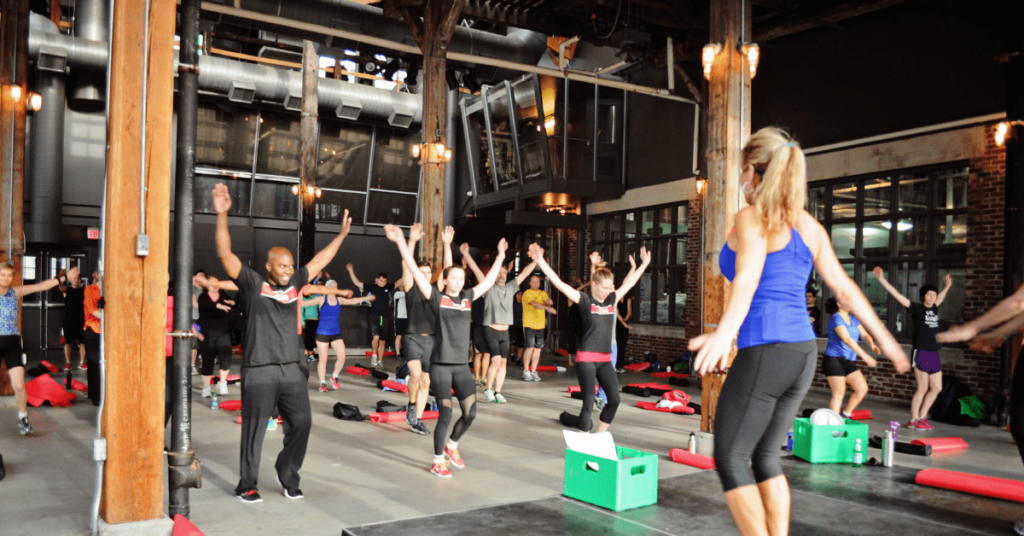We all know that it can be a big challenge to get some members turning up to the studio, and motivation plays a big part in that. Successfully motivating your members to turn up regularly will have a knock-on effect throughout the business with an improvement in client retention and referrals, which ultimately grows your fitness business.
So the question is, what is motivation, and how can we optimize it for a fitness studio?
Motivation is defined as the process that initiates, guides, and maintains goal-oriented behaviors. Essentially, it is the driving force behind people setting and achieving their long term goals. Members can be motivated through things like competitions, adding special classes for different seasons of the year, keeping a positive and uplifting environment, celebrating lifestyle changes, setting attainable goals, offering rewards for fitness challenges, and utilizing social media for increasing client motivation.
In this article, we will discuss these motivation strategies and also talk about the basic idea behind motivation and the role it plays in your studio’s success.
Motivating Your Members
We know motivation is the driving force behind goal achievement, so the next stage is to figure out how you can apply this to your members. People are more likely to stay on track with an activity or behavior if they’re successful, feeling confident, or are noticing some value that is being placed on the action.
What Is the Psychology of Motivation?
Most decisions that are made within our daily lives have a foundational focus of some sort of motivation – for instance, if we are hungry, we eat. If we’re thirsty, we drink.
Let’s delve a bit deeper, though – what happens in your brain when you’re motivated to do something? There are messengers in the brain called neurotransmitters, and they carry information throughout the body. Dopamine is one of those neurotransmitters that are vital in the scope of motivation, and this is because when it reaches certain areas of the brain, it persuades us to either accomplish something positive or to dodge something negative. Essentially, highly motivated people are shown to have more dopamine in certain parts of the brain, which have significant impacts on overall reward and motivational aspects of life, including those in the workplace, at home with family, and in the realm of health and fitness, although there are many more!
Since motivation is kick-started by these spikes in dopamine (seeing as how your brain is perceiving that something big is about to happen), it can have a significant impact on how productive you are. Dopamine increases when a person is involved in rewarding and positive experiences. The increase can come from things like completing small tasks throughout the day and staying on task, being productive and organized with your workload, getting praise and recognition for work done in the gym or reaching a fitness goal
These types of goals and achievements would be considered either extrinsic or intrinsic motivational factors. Extrinsic motives fulfill needs like sleep, food and drink, and the feeling of being connected with others, while intrinsic motives meet needs like being accepted by others and doing activities that boost self-esteem.
Motivated Members Grow Your Studio
Now that we know the science behind motivation, how does this correlate with the members in your studio and overall improving your business? A big part of being in the fitness and wellness world is being able to build motivation, rapport, and trust with your clients.
If motivation is at the heart of your business and you can help your clients find their reason for loving fitness and being proud of what they can achieve, they’ll keep coming back for more.
We will now look at how group training and personal training differ and compare when it comes to motivating members.
The Customer
Engagement Playbook
for Your Fitness
Business
Discover more Group Fitness vs. Personal Training as Motivation
So, are there advantages to participating in group fitness activities versus one-on-one personal training sessions when it comes to levels of motivation?
Group Fitness: A group fitness instructor is typically not only trying to help everyone enjoy their workout, but they are also working to keep everyone moving safely and performing exercises with proper form. This can be challenging, especially with a class that has many participants. With that being said, the instructor is not going to be giving personal attention to any one person – they have to be able to divide up their attention over the entire class. So while the group fitness experience can be a lot more beneficial in terms of getting fit, it can sometimes lack quality control in terms of checking for correct form.
Recently, a Nielsen study of more than 3,000 participants of group fitness classes around the world highlighted that more than 85% of class members visit their facility twice a week specifically to engage in group classes. And 43% of members visit their facility four times per week for this purpose.
Personal Training: With a personal trainer, you have someone by your side through your entire workout. This person knows what you want to accomplish, your health history, what motivates you, and will point you in the right direction to achieve your goals. Personal trainers give you 100% of their attention, and this, in turn, leads to better form and increases the safety of movements within the gym. Personal training also helps to ensure consistency through workouts and goal setting sessions, and will continuously be enforcing progress. With a dedicated coach right there by your side (even on the days you don’t feel like doing it), you can reach your goals! Personal training does usually come with a hefty price tag – and is not typically included with a gym membership – but can be invaluable if you need a bit more of a one-on-one fitness boost.
7 Ways You Can Motivate Members in Your Fitness Business
Let’s break down seven different ways that you can motivate members, increase retention, and have your clients get the most out of their programs!
Offer rewards: Incentives and rewards are a great way to form supportive relationships between gym members and can help build a sense of support and connection between you and your clients. Along with feeling appreciated, rewards help people feel excited to be a part of something like a fitness center and can keep them engaged with activities and events going on within the gym. Even simple things like water bottles, keychains, towels, and stickers/magnets can be a huge win! Other incentive ideas include free personal training sessions, a swimming pool pass, or a month of free membership.
Use social media: Social Media platform are very popular and are one of the quickest ways to boost client motivation. This can be done through sending encouraging messages, marketing upcoming classes and sessions for current clients and new members, and creating groups and posts for members and clients to post their workouts, goals, and accomplishments in a positive and nurturing environment. Emails are also another direct way to stay in touch with clients and can save you time when delivering important information regarding future events, sales on personal training, and even passing along recipe recommendations to help keep clients on track.
Set up fitness competitions: This doesn’t have to be as hardcore as it sounds; in fact, it can be set up in such a way so that each client and member succeeds! Adding in a competitive element is not for everyone, and some folks aren’t motivated this way – but, for the ones that are, kicking it up a notch with a little friendly competition can be a fun and enticing way to reach goals and interact with other gym-goers! Structure is also a significant part of fitness challenges, so that in and of itself can help clients stay focused. For more information on setting up a fitness challenge take a look at our recent article on the topic.
Keeping a positive environment: It seems like something that we all know already, but there is something to be said about fun and uplifting environment, especially in a place like a gym where people might already feel a bit uncomfortable. Keep your members motivated by creating an atmosphere that is welcoming, and this will pay out tremendously in helping them not only accomplish goals but feel as though they are a part of something. Communication is critical, and even more so in a fitness and wellness arena – increase the self-esteem of your clients, and not only will you feel better about giving them a smile, but they will inevitably see progress within their workout programs, and with the relationships, they’ve fostered while at the gym!
Celebrating lifestyle changes: There are so many ways you can celebrate and encourage the significant victories that clients achieve in their fitness journeys…but what about the small ones?! Granted, these will all be relative and different for every client you come across – but, if someone makes it a goal to hit the gym three times in one week (and they do it), then celebrate! Hitting your water intake goal each day, when before you barely had any? Another reason to celebrate! It might seem silly, but these little instances that happen as a result of some sort of change are something to be recognized and can help boost motivation over the long run and increase the sense of an athletic accomplishment.
Setting Attainable Goals: Motivation can be lost if the wrong goals are set;h this can be in regards to how specific the goal is, how measurable/attainable it is, how realistic the goal is, and the proper timeline needed to achieve it. For example, if someone wants to lose fifty pounds in the next month, it’s probably best to sit down with them and break down some smaller, specific goals that they can achieve in those four weeks – ones that will help lead them to their larger, more long-term goal! This way, the client still feels successful but has the knowledge of what needs to be done and the proper way to go about it without burning out, getting de-motivated, or getting injured.
Adding special classes throughout the year: There is certainly nothing wrong with a classic, regular group exercise schedule that your members and clients can count on. They can pick and choose the classes that they like that work within their schedule, know who their instructors are, and can establish a rapport with the other members in their class. However, throwing in some fun seasonal classes can shake things up a bit – and in a good way!
Table of contents














